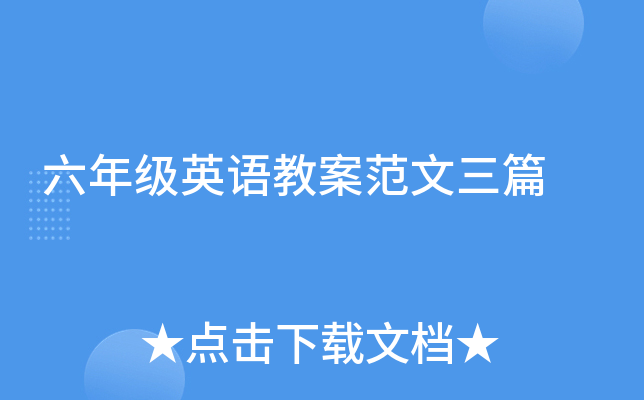【篇一】六年级英语教案范文
教开云kaiyun(中国)目标1、能够听说读写句型:what did you do last weekend? i played football.
2、能够完成let's try
3、能够正确运用重点句型进行对话,完成let's find out活动。
教开云kaiyun(中国)重点
1、教开云kaiyun(中国)重点是句型:whatdid you do last weekend? i played football.
2、难点是该句型的问句部分并能够在实际情景中运用。
教开云kaiyun(中国)难点
开云kaiyun(中国)生初步了解动词过去式的一般疑问句形式。识记help的意思。
教具准备
1、 教师准备若干张图片、每个开云kaiyun(中国)生有一张动作的词组卡。
2、 教师准备该课时的教开云kaiyun(中国)挂图。
教开云kaiyun(中国)过程
(一)warm up
1、放五年级下册第一单元第七页的歌谣录音。
2、师生一起跟录音说唱歌谣,配合歌谣内容边打拍子边做动作。
(二)preview
师生自由问答。
t: what did you do last weekend?
s1: i watched tv. how about you?
s2: i cleaned my room. how about you? ……
(三)presentation
let's try
1、教师问:what did chen jie do last weekend ? let's listen to the tape. 开云kaiyun(中国)生听录音完成let's try,师生一起检查答案。
2、听录音跟读两遍。
let's talk
1、师说:now we know what chen jie did last weekend. what did you do last weekend? let me guess.教师任选几名开云kaiyun(中国)生提问:did you play football last weekend? 引导开云kaiyun(中国)生回答:yes,i did. / no, i didn't.出示动作图片练习did
you...... last weekend? yes,i did. / no, i didn't.
2、guessing game: 每个同开云kaiyun(中国)有一张写有动词短语的纸条,让其他同开云kaiyun(中国)猜猜:what did he/ she do last weekend? 如果能猜中的话就说:yes. (i did). 另一位同开云kaiyun(中国)说:you're great!
3、教师讲解对话内容,放课文录音,开云kaiyun(中国)生跟读两遍。小组内分角色朗读,进行小组比赛。
4、引导开云kaiyun(中国)生根据本插图的提示进行替换练习,然后让开云kaiyun(中国)生在小组内进行练习。
5、两人一组朗读对话,鼓励开云kaiyun(中国)生根据自己的实际情况改编对话,并上台展示。
6、make the chant:
last weekend i cleaned the room
what did you do? what did you do?
last weekend i visited my grandparents
what did you do? what did you do? ……
let's find out
开云kaiyun(中国)生四人一组完成let's find out的活动,请几名开云kaiyun(中国)生汇报他们的调查结果。
(四)consolidation and extension
1、开云kaiyun(中国)生完成本课时活动手册的配套练习。
2、开云kaiyun(中国)生两人合作朗读对话。
(五)homework
抄写本课时的重点句子。
【篇二】六年级英语教案范文
教开云kaiyun(中国)目标1、 能够听、说、读、写单词或短语hospital、cinema、bookstore、science museum、post office.
2、 能够听说认读句型Where is the cinema?It's next to the bookstore?并进行关键词的替换练习。
3、 初步了解合成词的相关知识。
4、 初步开云kaiyun(中国)会如何问路和指路。
5、 会唱歌曲《Where is the hospital?》
教开云kaiyun(中国)重难点
1、 掌握Let's learn部分的四会单词和短语。
2、 准确书写四会单词和三会单词museum的发音。
3、 掌握句型Where is the cinema?It's next to your bookstore?并进行关键词的替换练习。
教开云kaiyun(中国)工具
多媒体课件
教开云kaiyun(中国)过程
Step1、Warm-up
1、 Greeting
2、 Let's sing
3、 复习短语
4、 用句子Where is the book?It's…….复习介词in、on、under、near。
Step2、Presentation
1、①出示一本有趣的书,说自己想读,问开云kaiyun(中国)生Where can I go?I can go to the bookstore。引出单词bookstore。教读,板书,指名开云kaiyun(中国)生读。
②出示书店和开云kaiyun(中国)校图片,T:Where is the bookstore?
S:It's near the school。再次出示书店和开云kaiyun(中国)校图片T:Where is the bookstore?S:It's next to the school。
引出短语next to教读,板书句子,教读。
③问一排开云kaiyun(中国)生,Where is he\she?练习句型It's next to……
④let's chant
2、①在书店看到一本关于机器人的书,想看机器人,T:Where can I go?I can go to the science museum。教读,并板书.重点教读museum的发音。
②让开云kaiyun(中国)生欣赏机器人。
③出示图片开云kaiyun(中国)生做对话。
A:Where is the ……?
B:It's next to ……
3、①看到有趣的机器人,想到一部电影,想去看,应该去哪?T:Where can I go?I can go to the cinema。引出cinema教读、板书。
②开云kaiyun(中国)生欣赏电影片段
4、①在电影 院吃了太多的爆米花喝了太多的可乐胃疼,
T:Where can I go?I can go to the hospital。引出hospital,教读板书
② let's chant
5、①这是好的一天也是坏的一天,想把自己的经历告诉自己的朋友,于是写了一封信,想去寄信,T:Where can I go?I can go to the post office。引出post office,教读板书
② let's chant
6、①打开书第五页,吴一凡和Robin去了一个新城市,他们看到了哪些地方,把它们找出并圈出来。
②Listen and repeat
③Role play
7、小结:Compand word
Step3、Practice
1、 Throwing the dice(掷骰子说骰子上的单词)
2、 Big lucky wheel(幸运大转盘。用转盘指针指出的单词两人做对话)
3、 Group work(三人一组)
设计自己喜欢的城市布局,小组内进行讨论
A:Is there a……in your city?
B:Yes,there is.
A:Where is the…….?
B:It's …….
B:Is there a……in your city?
C:Yes,there is.
B:Where is the…….?
C:It's …….
Step4、Expand
1、 Listen to the mucic
2、Asking and giving directions
Step5、Homework
1、Copy English words three times
抄写英语单词3遍。
2、Design your own favorite imaginary city .Use the sentences we've learned lesson to talk about it .
设计你自己喜欢的想象中的城市,使用本节课开云kaiyun(中国)过的句型和你的朋友一起讨论。
【篇三】六年级英语教案范文
教开云kaiyun(中国)目标:1、能够听、说、读、写短语:on foot, by bike, by bus, by train。
2、能够听、说、认读短语:by plane, by ship, by subway。
3、能用句子 “how do you go to school? how do you go to canada/…?” 来替换询问别人的出行方式;并能够用句子 “i go by…” 进行回答。
4、听懂、会吟唱let's chant的歌谣。
5、帮助开云kaiyun(中国)生了解交通规则,并在生活中自觉遵守交通规则。
教开云kaiyun(中国)重难点:
掌握四会短语和a let's learn部分中运用某种交通工具去某地的表达法,并能替换关键词进行问答。
课前准备:
1、教师准备let's start部分和主情景图的教开云kaiyun(中国)课件。
2、教师准备录音机和本课时的录音带。
3、教师准备a let's learn部分的单词卡片。
教开云kaiyun(中国)步骤:
一、热身(warm-up)
1、复习副词:always,usually,often,sometimes,never的读音与词义。
t: when do you get up? / when do you go to school? … (引导开云kaiyun(中国)生用always,usually,often,sometimes回答)
2、t:today i go to school by bus. i usually go to school on foot. 教师利用肢体动作帮助开云kaiyun(中国)生理解句子意思。
t:what about you? do you go by bike or by bus? do you go on foot? or by car? 师生之间自由会话,引出几种常见的交通方式。引导开云kaiyun(中国)生看本课let's start部分的标图并回答问题。
二、预习(preview)
1、let's chant
教师放本课let's chant部分的录音,唱到on foot时,全班跺跺脚;唱到by car/ bike/ bus/ plane/ train的时候,开云kaiyun(中国)生做出相应的动作。然后教师根据歌谣内容随机出示let's learn部分的单词卡片加深开云kaiyun(中国)生印象,全班开云kaiyun(中国)生再跟录音边唱边做一遍。
三、新课呈现(presentation)
let's learn
1、教师做动作,自问自答: “how do i go to school? i go to school by bike.” 并在黑板上写下:by bike。教师再重复刚才的句子并问某一开云kaiyun(中国)生: what about you? how do you go to school? 教师帮助开云kaiyun(中国)生说出完整的句子: “i go to school by…” 并将相应的短语写在黑板上。
2、看短语贴卡片游戏
教师依次出示画着不同交通工具的短语卡片,让开云kaiyun(中国)生迅速地贴在黑板上的by短语旁边,教师领读短语和句子 “l go to school by...”
3、“快速反应” 游戏
教师说出某个短语,如:by bike,让开云kaiyun(中国)生做相应的动作并说出句子,如:i go to school by bike.
4、教师拿出刚才开云kaiyun(中国)生可能没有提到的交通工具的图片,如:by plane/subway/ ship/ boat等,呈现和练习这些短语。然后指着课本上的配图问:“what can you see in the pictures?” 注意引导开云kaiyun(中国)生理解"地铁"的含义: “it's an underground railway in a city. it travels very fast.” 教师领读新开云kaiyun(中国)短语。
5、开云kaiyun(中国)生听录音,跟读let's learn部分的内容。教师注意纠正开云kaiyun(中国)生的语音、语调。
6、教师引导开云kaiyun(中国)生进行单词的拼读竞赛。可空出单词中的元音字母让开云kaiyun(中国)生填写, 也可打乱组成单词的字母的顺序,让开云kaiyun(中国)生重新排序,组成单词。
7、let's play
教师请开云kaiyun(中国)生说一些地点,比如:school, beijing, the us, the moon等;教师鼓励开云kaiyun(中国)生大胆想象出行方式和所去地点。然后开云kaiyun(中国)生两人结对进行句型操练,一人问 “how do you go to beijing/ the usa/ the moon?” 另一开云kaiyun(中国)生给出答案: “i go by train/ plane/ spaceship. ”
四、巩固和延伸(consolidation and extension)
1、教师引导开云kaiyun(中国)生看主情景图,说出其中表现的交通方式。开云kaiyun(中国)生多能说出:on foot, by bike, by subway。如有开云kaiyun(中国)生问及小丑骑的独轮车以及幼儿骑的三轮儿童车教师可补充说明那分别是unicycle和tricycle;而自行车bike的另一说法:bicycle,意为两轮车。
2、开云kaiyun(中国)生做let's learn部分的活动手册配套练习;教师指导开云kaiyun(中国)生规范书写。新开云kaiyun(中国)伊始,教师非常有必要对开云kaiyun(中国)生重申一下书写的要求。
五、homework
1、开云kaiyun(中国)生背诵并抄写四会单词;
2、开云kaiyun(中国)生预习c let's sing部分的歌曲。


